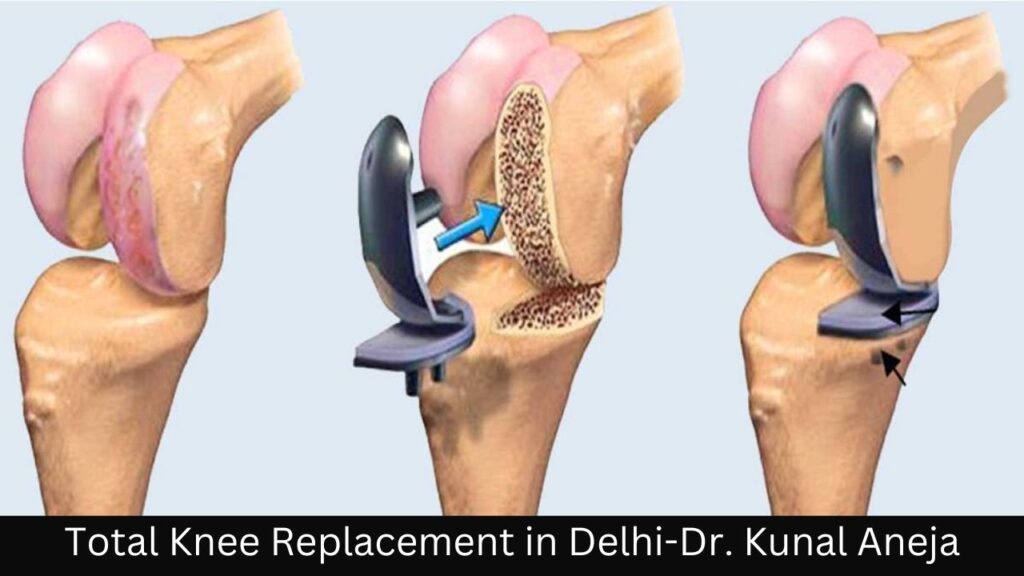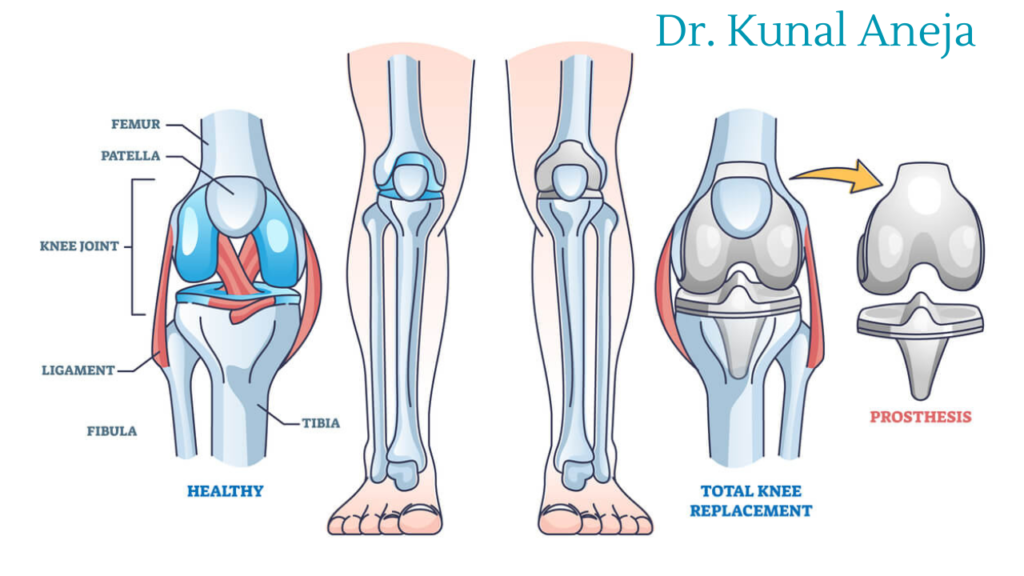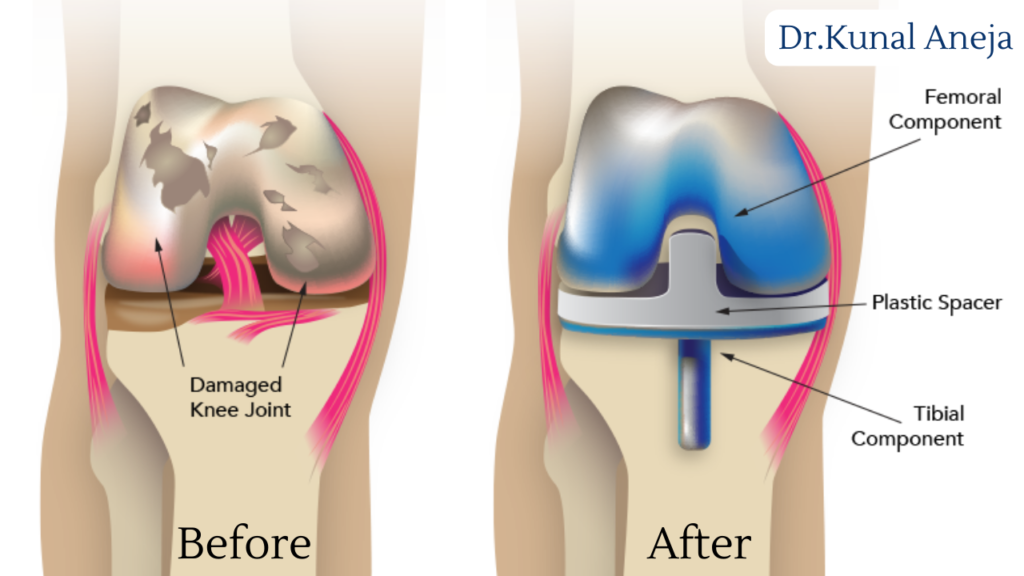
Dr. Kunal Aneja is recognized as the top knee joint replacement surgeon, known for his exceptional skills and dedication to helping patients regain mobility and improve their quality of life. With a deep understanding of the complexities of knee joint issues, he uses the latest techniques and technology to ensure successful surgeries. Patients trust Dr. Aneja not just for his expertise, but also for his compassionate approach to care, making him the go-to expert for anyone looking to overcome knee problems and get back to their active lifestyle.
What is Knee Joint Replacement Surgery
Knee joint replacement surgery is a medical procedure where a doctor replaces a damaged knee with an artificial part. It’s like fixing a broken toy by swapping out the broken piece with a new one, so it works smoothly again. This surgery helps people who have a lot of pain or trouble moving their knee because of damage or wear and tear. After the surgery, patients can move around easier and feel less pain, making it easier for them to do everyday activities and enjoy life more.

What are the Types of Knee Replacement Surgery?
There are mainly two types of knee replacement surgeries:
- Total Knee Replacement: This is when the whole knee joint is replaced with an artificial part. It’s like getting a brand new knee because the damaged parts of your knee, including the end of your thigh bone, the top of your shin bone, and sometimes the underside of your kneecap, get replaced with metal and plastic parts.
- Partial Knee Replacement: This surgery is done when only a part of the knee is damaged and needs to be replaced. Imagine fixing just one side of the knee instead of the whole thing. It’s less invasive than a total knee replacement meaning the surgery is smaller, recovery can be faster, and it keeps more of your knee’s natural parts in place.
When a Knee Replacement is Needed?
A knee replacement is usually needed when your knee is damaged or worn out and it hurts a lot or makes it hard for you to do everyday things like walking or climbing stairs. This damage can be because of arthritis, where the cushioning cartilage in your knee breaks down, or due to injuries or other knee problems. Basically, if your knee pain is really bad and other treatments like medicine or physical therapy haven’t helped much, a doctor might suggest replacing the damaged parts of your knee with new, artificial parts to help you move easier and feel less pain.

What is Arthritis
Arthritis is when your joints get inflamed, which means they swell up, get warm, and often hurt. It’s like your body’s hinges (where two bones meet, like in your fingers, knees, or elbows) getting rusty and stiff, making it hard and painful to move. There are different types of arthritis, but the most common kinds make your joints wear out over time or cause your body’s defense system to attack those joints. It can make doing everyday things tricky because of the pain and stiffness.
Understanding Arthritis
Knee Arthritis can make everyday life very difficult. There are three types of arthritis that you can have in your knee:
1. Osteoarthritis (OA): This type of arthritis is due to wear and tear on your joints over time. It causes the cartilage to deteriorate and can result in bone rubbing on bone. Understanding Arthritis
2. Rheumatoid arthritis (RA): This type of arthritis is caused by an autoimmune disease that attacks various joints throughout the body. The disease is chronic and inflammatory in nature and damages
ligaments and cartilage while softening the bone.
3. Post-traumatic arthritis (PA): This type of arthritis will develop after a trauma or injury to the knee. It may not develop until years after the injury.

Benefits of knee replacement surgery
Knee replacement surgery comes with several benefits that can significantly improve the quality of life for people suffering from severe knee pain and mobility issues. Here’s a breakdown:
- Pain Relief: The most immediate and noticeable benefit is a dramatic reduction in knee pain. After recovery, many patients experience a significant or complete relief from the pain that plagued their daily lives.
- Improved Mobility: Knee replacement can greatly enhance mobility, making it easier to perform daily activities like walking, climbing stairs, and standing up from a chair, which might have been difficult or impossible before the surgery.
- Better Quality of Life: With the reduction in pain and improvement in mobility, overall quality of life improves. Patients often find they can return to many of the activities they love but had to give up due to their knee issues, such as gardening, biking, or playing with their grandchildren.
- Long-lasting Solution: Knee replacements are designed to last for many years. With advancements in surgical techniques and prosthetic materials, many knee replacements now last 20 years or more, providing a long-term solution for patients.
- Correction of Deformity: Knee replacement surgery can correct significant knee deformities, allowing the leg to be straightened and stabilized, which improves the patient’s ability to walk and reduces the wear and tear on other joints.
- Increased Strength: After recovery and with proper rehabilitation, many patients find their knee strength improves, thanks to the elimination of pain and the ability to engage in physical therapy and exercise.
Overall, knee replacement surgery can offer a new lease on life for those suffering from severe knee problems, allowing them to enjoy more active and fulfilling lives with less pain and greater independence.

What Precautions to take after Knee Replacement?
After knee replacement surgery, taking certain precautions can help you heal properly and get the most out of your new knee. Here’s what you should keep in mind:
- Follow Your Doctor’s Advice: Listen carefully to your doctor or physical therapist and follow their instructions for care and exercises. They know what’s best for your specific situation.
- Take It Easy: Don’t rush things. Give your body the time it needs to heal. Avoid overdoing activities, especially those that might strain your new knee.
- Mind Your Movements: Be careful with how you move. Avoid twisting or turning your knee suddenly. Use a cane or a walker until your balance improves and you feel more confident.
- Keep Up with Exercises: Physical therapy is crucial for your recovery. Stick to the exercise routine recommended by your therapist to strengthen your knee and improve flexibility.
- Watch Your Weight: Keeping your weight in check can reduce the pressure on your knee and help your replacement last longer.
- Protect Against Falls: Make your home safer to prevent falls that could damage your new knee. Remove loose rugs, keep cords out of the way, and ensure your home is well-lit.
- Check for Infections: Keep an eye on your incision. If you notice redness, swelling, or drainage, or if you have a fever, contact your doctor right away as these could be signs of infection.
- Attend All Follow-Up Appointments: Your doctor will want to check on your progress and make sure your knee is healing correctly. Don’t skip these appointments.
By taking these precautions, you can help ensure a smoother recovery and a better outcome from your knee replacement surgery.

